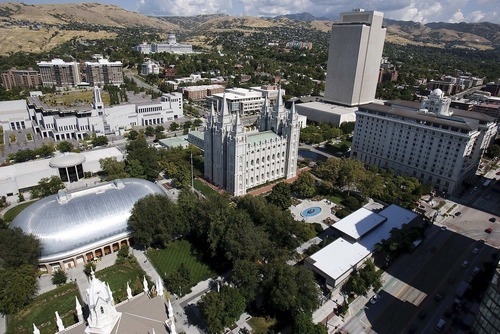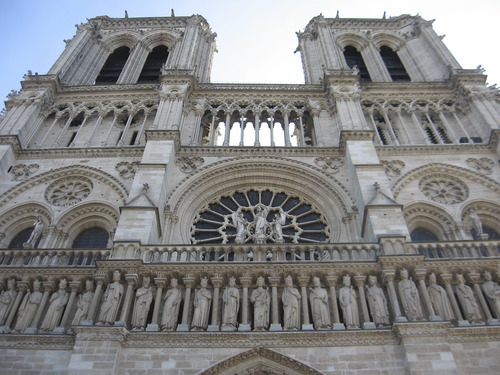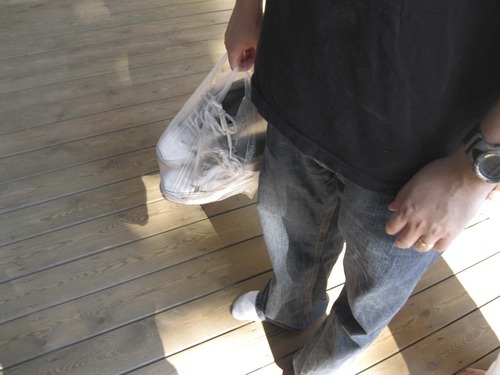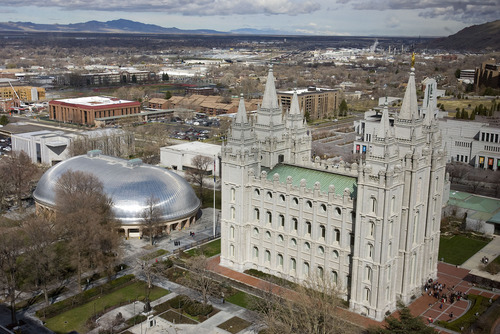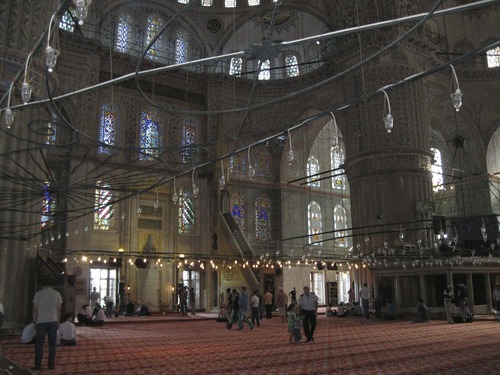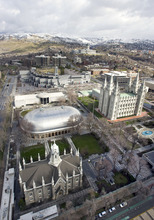This is an archived article that was published on sltrib.com in 2011, and information in the article may be outdated. It is provided only for personal research purposes and may not be reprinted.
Not everyone who visits Temple Square in Salt Lake City is Mormon. Catholics aren't the only ones who trek to St. Peter's Basilica in Vatican City. And the Blue Mosque in Istanbul, Turkey, draws tourists of all faiths.
For most international travelers, visiting religious sites is inevitable. They are hubs of history, repositories of art and often skyline-dominating, cultural behemoths. But they also are often living places of worship that demand a certain level of respect and decorum. Sometimes tourists don't know all the rules when visiting sites outside of their own faiths. And sometimes they forget to show proper respect in their zeal to sightsee.
Travel expert Rick Steves, who has authored numerous travel guides, said visiting world religious sites is a worthwhile endeavor.
"If we're all God's children," Steves said, "it's great to get to know the family."
But he emphasized it's important for tourists to remember their place.
"If you have a huge church," Steves said, "that's been there for 1,000 years, built to facilitate worship, and there's two people sitting in one pew actually using the church for what it was built to do, their needs should trump everyone else's needs who come as tourists and sightseers."
The Salt Lake Tribune asked Steves, a virtual staple on public television, and Stuart M. Matlins, co-editor of the book How to Be a Perfect Stranger: The Essential Religious Etiquette Handbook and publisher at SkyLight Paths Publishing, for their thoughts on visiting religious sites as a tourist.
They both said whether visiting the gargoyle-topped Cathedral of Notre Dame in Paris, the sacred Western Wall in Jerusalem or the stately Westminster Abbey in London, common rules of respectfulness apply.
"Personal demeanor and behavior is constant across all religious traditions," Matlins said. "Be quiet, be humble and be respectful."
Matlins said that includes, for example, not walking up and down the center aisle of a church when a service is under way. Tourists should stay around the edges then.
Steves said tourists should also be respectful by not taking photos of other people worshipping "as if they're at some sort of Kodak Hula show," referring to an old Hawaiian dance show for tourists in Waikiki.
And Matlins said it's important to dress respectfully. That can mean forgoing shorts, miniskirts and tank tops. Steves said if travelers know they might be visiting religious sites, they should avoid wearing shorts and shoulder-baring tops that day.
Both Matlins and Steves said, unfortunately, it's not unusual to see tourists behaving badly when visiting great religious sites.
"As somebody who travels a great deal and always visits places of worship of different faiths," Matlins said, "all too often people forget that they're in someone else's home, not a museum."
He and Steves said a basic rule of thumb when visiting any religious site is to look around, see what others are doing and act accordingly.
"I don't really try to remember all the specific niceties and etiquette points for different cultures," Steves said. "When I'm there, it's very clear what is appropriate."
Steves said the most important reminder is to be "in a thoughtful and respectful and worshipful frame of mind."
Matlins said when in doubt about specific rules, it's best to err on the side of respectfulness. Just because some women might not wear head scarves in the Blue Mosque, for example, doesn't mean others shouldn't try.
"There's no such thing as being too respectful of other people's traditions," Matlins said.
Those who act respectfully in other people's houses of worship stand to take away more than just an appreciation for the art and history of the places. Matlins said one of his favorite traveling ventures is to attend religious services of various faiths, especially if he cannot understand the language.
"Then I can focus entirely on the affect and the spiritual experience and the ritual," Matlins said, "without getting distracted by the theology."
He said it's interesting to listen to services with one's eyes, one's ears and one's heart.
"People going to the religious services of others for the spiritual experience, I think, is all too rare," Matlins said. "I think the rarity is because people think they won't be welcomed or they'll be intruding, and in all the places I have gone I have never found that, not once, to be the case."
Steves recently posted photos on his Facebook site of the five places in Europe that are most spiritual for him: the Swiss Alps; Spain's Camino de Santiago Pilgrimage Trail; Assisi, Italy, the town of St. Francis; St. Peter's Basilica; and the ecumenical monastic community of Taizé, France.
"I love visiting sites of all different faiths," Steves said. "It gives you perspective on the fabric of the community, of how parents love their children, how people are concerned with their relationship with God."
Such travel can help people embrace diversity and overcome fear.
"Fear," Steves said, "is for people who don't get out very much."
Twitter: @lschencker —
Tips for visiting religious sites
International travelers who want to visit religious sites should be respectful when they're in others' houses of worship, said Stuart M. Matlins, co-editor of How to Be a Perfect Stranger: The Essential Religious Etiquette Handbook. Still, faiths can have slightly different expectations of visitors, including those who are merely passing through and those who want to stay for services. Below are some general tips for those visiting places of worship.
Catholic churches • At St. Peter's Basilica in Vatican City tourists are expected to wear clothing or scarves that cover their shoulders and legs. Generally, during a Sunday Mass at any Catholic church, men should wear a jacket and tie and women should wear a dress, skirt or nice pants. Clothing should be modest. Those who attend services but are not Catholic are expected to stand when the congregation stands, but kneeling, reading prayers aloud and singing are optional. Non-Catholic visitors should not receive communion and instead remain in their seats while congregants take part.
Muslim mosques • Visitors will be expected to remove their shoes, which they will then often put on a shelf near the entrance. At some mosques, such as the Blue Mosque in Istanbul, Turkey, visitors will be given a plastic bag in which they can carry their shoes as they tour the mosque. Women should cover their hair with a scarf, cover their arms and have hemlines reaching below the knees. Men can wear casual shirts and slacks. Non-Muslim visitors who attend during a service won't be expected to do anything other than sit, and non-Muslims should not prostrate themselves to pray.
Jewish synagogues • In Orthodox, Conservative and Reconstructionist congregations, a small head covering called a yarmulke is required for men and usually available just outside the main sanctuary. Yarmulkes may or may not be required at Reform congregations. At some Conservative synagogues, women might also be required to wear a hat or other head covering. In Orthodox congregations, women's arms should be covered and hems should reach below the knees. Non-Jews are not expected to wear a tallit, or prayer shawl. In Orthodox prayer settings, men and women typically are separated. Visitors who attend a service and are not Jewish are expected to stand when the congregation stands but do not have to read prayers aloud or sing with congregants. At the Western Wall in Jerusalem, men and women must stand in different places along the wall and wear modest clothing.
Buddhist temples • Some temples expect men to wear a jacket and a tie and women a dress or skirt, but most allow more casual clothing. No head covering is required, and there are no rules about colors. Visitors should avoid entering or leaving during meditation. For visitors who attend a service but are not Buddhist, chanting and standing when other congregants do is optional. Avoid talking during services.
Hindu temples • Visitors may dress casually and don't necessarily need to cover their heads, arms or legs below the knees and may wear any color. Visitors may sit wherever they wish on the floor. They will be expected to remove their shoes before entering, often leaving them on a shelf at the entrance to the temple. During services, sacramental food called prasad may be served but guests may abstain without offending. Visitors who are not Hindu but attend a service are welcome to participate but are not expected to do anything other than sit.
Greek Orthodox • Visitors and tourists will want to ensure their shoulders and legs are covered. Head coverings are not required. When attending a Sunday service, it's recommended men wear jackets and ties, and women wear dresses and/or clothing that covers the arms and have hems that reach below the knee. Visitors who attend services will be expected to stand when congregants do, though kneeling is optional, and non-Greek Orthodox visitors should not participate in Holy Communion.
Source: How to Be a Perfect Stranger: A Guide to Etiquette in Other People's Religious Ceremonies, Stuart M. Matlins and Tribune reporting




